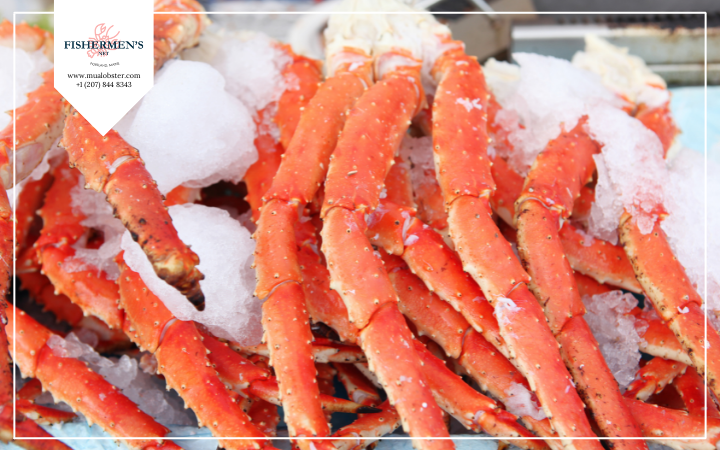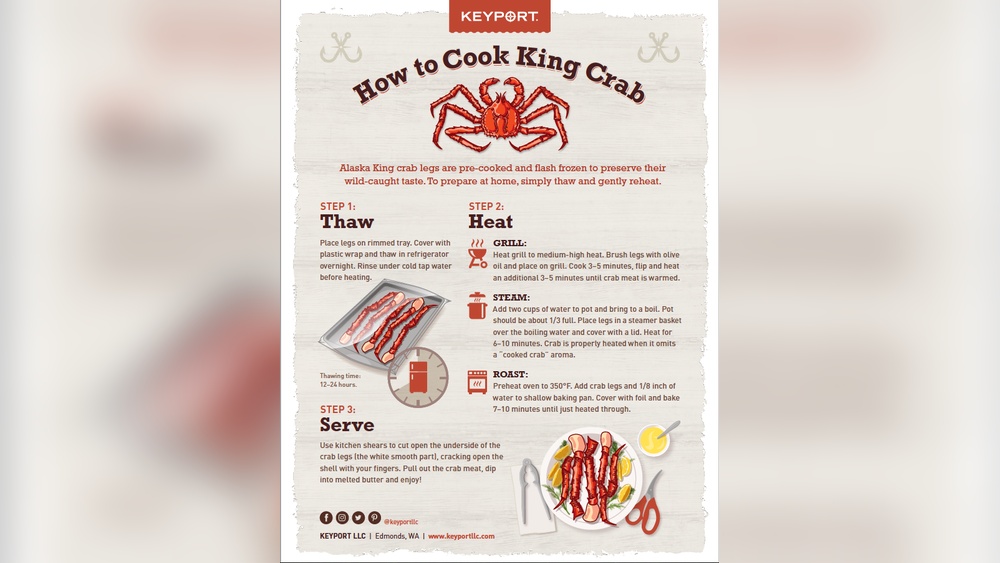Craving delicious crab legs but only have frozen ones on hand? You’re not alone, and the good news is that cooking frozen crab legs is easier than you might think.
Whether you want to steam, boil, bake, or grill them, this guide will walk you through simple steps to turn those frozen crab legs into a mouthwatering feast. By the time you finish reading, you’ll know exactly how to get tender, flavorful crab meat every time—without the hassle or guesswork.
Ready to impress yourself and your guests? Let’s dive in and unlock the secrets to cooking frozen crab legs perfectly.

Choosing Crab Legs
There are different types of crab legs to choose from. Popular kinds include snow crab, king crab, and Dungeness crab. Each has a unique flavor and size. Snow crab legs are smaller and sweet. King crab legs are large with thick shells. Dungeness crab legs have a rich taste and tender meat.
Frozen crab legs are more common and easy to find. They keep fresh taste for longer. Fresh crab legs can taste better but spoil fast. Frozen crab legs are good for cooking anytime.
Crab legs can be bought at seafood markets, grocery stores, or online. Seafood markets often have the best quality. Grocery stores offer convenience. Online shops can deliver fresh or frozen crab legs to your door.
Thawing Frozen Crab Legs
Refrigerator thawing is the safest and easiest way to thaw crab legs. Place frozen crab legs in a bowl or tray to catch drips. Leave them in the fridge for about 8 to 12 hours. This slow thaw keeps the crab legs fresh and safe to eat. Plan ahead because this method takes time.
The cold water bath speeds up thawing. Put crab legs in a sealed plastic bag. Submerge the bag in cold water, changing water every 30 minutes. Thawing usually takes about 1 to 2 hours. Avoid warm or hot water to keep crab legs safe.
- Do not thaw crab legs at room temperature.
- Keep crab legs in the bag to prevent water absorption.
- Cook crab legs immediately after thawing.
Steaming Crab Legs
Fill the pot with about 1-2 inches of water. Place a steamer basket inside, making sure the water does not touch the basket. Cover the pot with a tight-fitting lid to trap steam. Bring the water to a boil over medium-high heat. Place the frozen crab legs in the basket, spreading them out for even cooking. Cover the pot again to keep the steam inside.
Steam crab legs for about 5-7 minutes. The crab legs are done when they are hot and smell fresh. Avoid steaming too long to keep the meat tender and juicy. Check if the crab legs are heated through before serving.
Enhance flavor by adding lemon slices or garlic cloves to the water. A pinch of Old Bay seasoning or sea salt in the water can add a nice taste. Serve crab legs with melted butter or a squeeze of fresh lemon juice for extra flavor.

Boiling Crab Legs
Fill a large pot with water and bring it to a rolling boil. Use enough water to cover the crab legs fully. Adding salt enhances the flavor and helps the water boil faster. Once boiling, gently place the frozen crab legs into the pot. Avoid overcrowding to ensure even cooking.
Cook the crab legs for 5 to 7 minutes. Thicker legs may need a minute or two more. They are ready when they turn bright orange and smell fresh. Overcooking can make the meat tough, so watch the time carefully.
Season the boiling water with lemons, garlic, or Old Bay seasoning for extra taste. These simple additions infuse the crab legs with a delicious aroma. You can also dip the cooked legs in melted butter for a rich finish.
Baking Crab Legs
Set the oven temperature to 375°F (190°C) for baking crab legs. Use a baking sheet with a rim to hold any juices. Line the sheet with foil for easy cleanup.
Cooking time usually ranges from 15 to 20 minutes. Frozen crab legs need a bit longer than thawed ones. Check if they are hot all the way through before serving.
Brush crab legs with melted butter to keep them moist. Sprinkle spices like garlic powder, paprika, or Old Bay seasoning for extra flavor. Add lemon juice for a fresh taste.
Grilling Crab Legs
Start by cleaning the grill grates well to prevent sticking. Heat the grill to medium-high. Use indirect heat to avoid burning the crab legs. Brush the crab legs with olive oil or melted butter to keep them moist during grilling.
For marinating, mix lemon juice, garlic, and a pinch of salt. Let crab legs soak for 15-20 minutes to add flavor. Avoid long marinating times to keep the crab’s natural taste. Use a brush to apply the marinade evenly before grilling.
| Grilling Time | Method | Tips |
|---|---|---|
| 5-7 minutes | Direct heat | Turn crab legs once for even cooking |
| 10-12 minutes | Indirect heat | Cover grill to trap heat and steam crab |
Check crab legs for a warm inside and slightly charred outside. Avoid overcooking as crab meat becomes tough. Serve hot with lemon wedges and melted butter.
Serving Suggestions
Dipping sauces add flavor and fun to crab legs. Classic choices include butter with garlic and lemon juice. Cocktail sauce, made with ketchup and horseradish, gives a tangy kick. Aioli or spicy mayo offers a creamy twist. A simple soy sauce mix with ginger also works well.
For side dishes, steamed vegetables like asparagus or green beans complement the crab’s sweetness. Rice or crusty bread helps soak up tasty sauces. A fresh salad with crisp lettuce and tomatoes adds a light balance.
Presentation ideas make your meal special. Serve crab legs on a large platter with lemon wedges. Use shells as natural bowls for sauces. Garnish with fresh herbs like parsley or dill for a splash of color.
Reheating Leftover Crab Legs
Reheating leftover crab legs requires care to keep their flavor and texture. The best way is to steam or bake them gently. Steaming helps crab legs stay moist and tender. Place crab legs in a steamer basket over boiling water for 5-7 minutes. Baking is also good; wrap crab legs in foil and heat in the oven at 350°F (175°C) for 10-15 minutes.
Avoid overheating. Too much heat makes the meat dry and rubbery. Using a microwave is not ideal but can work in a pinch. Wrap crab legs in a damp paper towel and heat on low for 1-2 minutes. Check often to avoid overcooking.
| Method | Time | Benefits |
|---|---|---|
| Steaming | 5-7 minutes | Keeps crab moist and tender |
| Baking | 10-15 minutes at 350°F | Even heating, retains flavor |
| Microwaving | 1-2 minutes on low | Quick but risk of dryness |
Common Mistakes To Avoid
Overcooking crab legs makes the meat dry and tough. Watch the time carefully to keep them juicy and tender. Uneven thawing can cause cold spots inside the legs. Always thaw evenly by placing them in the fridge overnight or running cold water over them.
Skipping seasoning means missing out on flavor. Crab legs taste best with a little butter, lemon, or old bay seasoning. Seasoning before or after cooking brings out the natural sweetness of the crab.

Frequently Asked Questions
What Is The Best Way To Cook Frozen Crab Legs?
Steam frozen crab legs over boiling water for 5-7 minutes until heated through. Alternatively, boil or bake at 350°F for 10-15 minutes. Serve with melted butter and lemon for best flavor.
Do You Need To Thaw Frozen Snow Crab Legs Before Cooking?
No, you don’t need to thaw frozen snow crab legs before cooking. Cook them directly from frozen for best results.
Is It Better To Bake Or Boil Crab Legs?
Baking crab legs enhances flavor and texture, while boiling cooks them quickly and keeps meat moist. Choose based on preference.
What Is The Best Way To Heat Up Frozen Crab Legs?
Steam frozen crab legs over boiling water for 5-7 minutes. Alternatively, boil them in salted water for 4-5 minutes. Baking at 350°F for 7-10 minutes also works well. These methods preserve flavor and tenderness effectively.
Conclusion
Cooking frozen crab legs is simple and quick with the right method. Steaming, boiling, or baking all bring out great flavors. Always start with frozen crab legs and heat them properly. Add lemon, butter, or seasoning for extra taste. Serve hot and enjoy a delicious seafood meal.
Now you can confidently prepare crab legs at home anytime. Fresh, tasty crab legs are just a few easy steps away.

Yes, working as , Food Blogger and Product Reviewer for last 6 years. Here you will get amazing deals for Smart kitchen products. I am your best source for the latest update in cooking trends. I provide insightful articles, reviews, and analysis on cutting-edge kitchen gadget. My mission is to empower readers with the knowledge they need to stay ahead in a rapidly evolving coking world. Join me as we explore the future of food technology and how it shapes our lives today and tomorrow.





